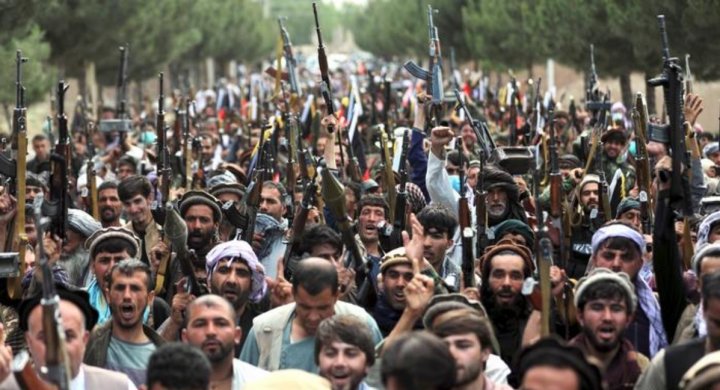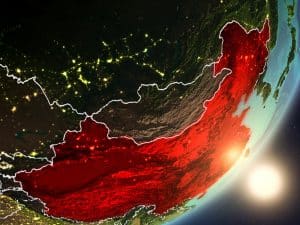The collapse of the Afghan government became a reality this Sunday, with the Taliban capturing the capital of Kabul after a devastating offensive that brought the government to its knees at an unimaginable speed. The Taliban now control more territory than at any time since the Taliban-installed Islamic Emirate of Afghanistan was overthrown by U.S. forces and their Northern Alliance allies in 2001.
As of Sunday, the Taliban and other Islamic insurgent groups had gained control over more than 200 of Afghanistan’s 410 districts since they began their offensive two months ago, capturing at least 21 provincial capitals out of 34 throughout the country and Kabul. During 2021, at least 5,500 people have been killed and wounded, mostly women and children, and nearly 300,000 people have been displaced from their homes according to the United Nations Mission in Afghanistan (UNAMA).
The catalyst for this sudden overthrow was the negotiated, almost unilateral U.S. withdrawal from the theater of operations, leaving behind a weak government which lacked legitimacy and was divided between President Ashraf Ghani, Vice President Abdulah Abdulah, and the still influential warlords, most of them accused of crimes against humanity, such as former Vice President Abdul Rashid Dostum. The withdrawal marks the end of an occupation that has killed more than 250,000 Afghanis, and left behind a devastated country whose economy, according to the World Bank, remains largely dependent on international support.
Many commentators have noted the similarities between the evacuation of Kabul and that of Saigon in 1975 as events that reveal the decline of U.S. imperialism and the failure of the U.S. policy of military intervention and regime change.
The occupation was from the beginning a geopolitical strategy conceived by U.S. neo-conservatives to regionally re-engineer Central Asia and the Middle East, and was aimed at preventing the rise of regional cooperation that marked the founding of the Shanghai Cooperation Organization (SCO) a few months before the fall of the Twin Towers on 9/11 and the invasion of Afghanistan. Afghanistan was thus once again a key country in the race for control of Central Asia.
The Advance of the Taliban
In February 2020, negotiations were opened and very brief agreements were signed in Doha, Qatar between American diplomats and the Taliban delegation headed by Mullah Abdul Ghani Baradar. The agreements included several core provisions: the withdrawal of U.S. and foreign troops within 14 months; a guarantee that the Taliban would not support groups like Al-Qaeda; and negotiations between the Taliban and the official Afghan government. In exchange, thousands of Taliban prisoners would be released.
A delegation headed by Vice President Abdulah Abdulah, head of the so-called “High Council for National Reconciliation,” has in recent weeks brought the government of Afghanistan to a new round of negotiations in Doha with the intention of negotiating a peaceful power transition. However, it is not known to what extent this is in agreement with President Ghani, Abdulah’s arch rival within the Kabul inner circle. Kabul’s weakness suggests that the conditions for negotiation are the same as those set in February 2020.
Negotiations cannot come out of the balance of power imposed on the territory, which is why the new U.S. administration of President Joe Biden adjusted the timetable established last year, and unilaterally announced the United States’ withdrawal to coincide with the anniversary of the attack on the Twin Towers, adding symbolism to what is clearly a defeat. While the Taliban high command have said they are committed to a “responsible” transition that respects the basic rights of the populations in Afghanistan, thousands of reports of abuses and violence are already coming in.
As U.S. troops leave the country, including from the emblematic Bagram base, the Taliban are gaining ground in many provinces: they already control 21 provincial capitals out of 34 with a force of around 100,000 fighters, and recently captured Kabul. Most of these cities were conquered without resistance because the government forces are retreating, withdrawing, deserting, or joining the mujahideen divisions in a process that is the reverse of the clashes of 2001 when the Taliban changed sides.The Taliban has also faced little resistance because, due to the weakness of the Afghan National Army, the elders of the villages have intervened to prevent massacres and further violence. The populations most committed to the occupation have fled to precarious refugee camps, which contain some 300,000 people.
Since 2014, the Taliban has gained a strong foothold in the north of the country, the former stronghold of the so-called Northern Alliance, an anti-Taliban coalition that resisted their rule between 1994 and 2001. From there, Taliban control spread to the center and south as they patiently established an ever-tightening siege on Kabul. The last cities conquered by the Taliban are Kandahar — the second largest city in the country, where the Taliban movement was born in 1994 — Herat, Lashkar Gah, Ghazni, and Pul-e-Alam, just 93 miles (150 kilometers) from the capital. Taliban fighters have recently conquered the northern anti-Taliban enclave of Mazar-i-Sharif, a city whose military organization is led by the veteran Uzbek warlord Abdul Rashid Dostum, former leader of the Northern Alliance, and his personal army.
The Taliban’s crushing victories in the northern cities, inhabited by Tajiks and Uzbeks and former footholds for the U.S. invasion in 2001, are indicative of a disturbing development. The Taliban strategy in their offensives against urban centers, many of which have more than a million inhabitants, has largely focused on gaining control of rural areas first before encircling their capitals, while securing cities and strategic border crossings. In this way, at the national level, they have managed to cut off much of the capitals’ supply lines, making them fall in a matter of hours.
Withdrawal of the United States and NATO?
The United States began its hegemonic decline from the moment it put its first boot on the ground in Afghanistan. It is interesting to observe the ups and downs of U.S. administrations, which not only respond to their visions of believing themselves to be the “center of the free world” but also to the needs of U.S. domestic politics. Such was the case of the 2011 raid in Abbottabad, Pakistan, to capture the then leader of Al-Qaeda, Osama Bin Laden.
President Biden is continuing the withdrawal initiated by Trump, writing off the fight over Afghanistan to focus resources on the “pivot to Asia” initiated by former president Barack Obama. However, the United States, after bombing Taliban positions over several days, will send 5,000 troops to secure Kabul’s international airport and help evacuate U.S. embassy staff, without giving asylum to the thousands of Afghans trying to escape the country.
But when John Kirby, the Pentagon spokesman, was asked why so many troops were being sent, he replied that the measure was “prudent preparation,” adding, “We want to make sure that we’ve got enough [troops] on hand to adapt to any contingencies.” The United States is trying to defend its diplomats and sensitive information as the Taliban now take Kabul.
The announcement of the deployment came on the same day the Taliban captured the city of Ghazni, bringing the group within 150 kilometers of Kabul. As Western powers line up to leave, it is hard to overstate the tragedy of a situation in which thousands have died, millions have become refugees, and billions of dollars in resources have been burned only for Afghanistan to paradoxically end up where it began 20 years ago.
The Rise of the Taliban and Areas of Influence
Afghanistan is strategically located in Central Asia. It is a so-called “pivotal state,” with vast consequences for the stability of the Middle East and the flow of natural resources in the oil, gas, and mineral-rich region.
As Argentinian socialist and researcher Gabriel Merino explains, Afghanistan is a buffer state that emerged in the 19th century “Great Game” between the British Empire and its colonial possessions in India, which sought to advance northward to Central Asia, and the Russian Empire, which sought an outlet to the Indian Ocean. This clash was decisive in delimiting the borders of Afghanistan. Throughout the 20th century, the country was at a crossroads between the interests of regional powers such as the Soviet Union, Pakistan, and China, causing constant instability, frustrated efforts at modernizations, and political regime changes.
By 1978, a pro-Soviet People’s Republic was established which attempted to impose a new political and social structure. Although it developed the country in various aspects like healthcare, agriculture, industry, and education, it underestimated the importance of tribal interests and the religious traditions of the people living there. This resulted in uprisings against the pro-Soviet government, which quickly led the USSR to intervene to prevent the collapse of the Afghan state. The USSR was trying to avoid the emergence of similar tendencies in Central Asia and reaffirm its role as a regional power in the context of an impending U.S. intervention in the bordering and newly born Islamic Republic of Iran after an uprising that overthrew the pro-Western monarchy of Shah Reza Pahlavi.
The occupation provided the U.S-backed mujahideen (“Islamic guerrillas”), as Ezequiel Kopel says, “a narrative of almost dreamed-of pious resistance … Afghan jihadism was empowered under the narrative of confrontation against invading foreigners, but it is also the bastard child of dysfunctionalities and divisions inherent to those societies.”
The Islamic Republic of Iran and its leader, Shiite cleric Rouholla Khomeini, changed the paradigm within Islam, radicalizing positions among strict Sunni tendencies such as Wahhabism, dominant in Saudi Arabia, which sought to regain the upper hand and counteract Persian influence. The Saudi monarchy financed centers of Islamic studies in Pakistan, Egypt, and other countries in the region. From there were born the first mujahideen who fought the USSR in Afghanistan (1979-1989) with the support of the CIA and its Pakistani counterpart, the Inter-Services Intelligence Directorate (ISI), as well as Chinese troops for whom countering the influence of the USSR in Central Asia was key, and numerous mercenaries and religious fanatics from all over the Islamic world.
The Taliban were formed in 1994 after the Soviet withdrawal (1989) and the expulsion of what was left of the secular government (1992). An ultra-orthodox faction of the mujahideen was led by the cleric Mullah Omar. They were joined by young Pashtun tribesmen who studied in Pakistani madrassas or seminaries funded mostly by Saudi Arabia (“Taliban” is Pashtun for “students”). Pashtuns comprise a majority in Afghanistan and are the predominant ethnic group in much of southern and eastern Afghanistan, and are also an important group in northern and western Pakistan. In this sense, the Taliban can be defined as an ethno-religious nationalist movement, determined to rebuild Afghanistan from a perceived strong past, capable of defending its own interests, and integrated into limited regional patterns of power and trade. The group’s rise is a product of both Stalinist Soviet policy and American imperialism.
The movement attracted some popular support in the post-Soviet era by promising stability and the rule of law after four years of conflict (1992-1996) between rival mujahideen groups. They entered Kandahar in November 1994 to pacify the conflict-torn southern city and, in September 1996, seized the capital, Kabul. That year, the Taliban declared Afghanistan an Islamic emirate. The regime controlled about 90 percent of the country before its overthrow in 2001.
The Taliban imposed a harsh brand of justice by consolidating territorial control. Taliban jurisprudence was drawn from the pre-Islamic tribal code of the Pashtuns and interpretations of sharia fed by the Wahhabi doctrines of the Saudi madrassas. The regime neglected social services and other basic state functions, even imposing bans on behavior that the Taliban considered un-Islamic. Women were required to wear head-to-toe burqas, music and television were banned, and any man whose beard was deemed too short risked imprisonment.
Since the United States entered Afghanistan under the dubious guise of dismantling international terrorist networks, the Taliban has withstood counterinsurgency operations by the world’s most powerful military alliance, NATO, three successive U.S. administrations, and a military occupation that reached 130,000 troops in 2011.
The Asia Foundation found in 2009 that half of Afghans, mostly Pashtuns and rural Afghans, sympathized with armed groups opposed to the government, mainly with the Taliban. Afghan support for the Taliban and allied groups was due to the failure of state institutions that were established with imperialist support.
But in 2019, a response to the same survey found that only 13.4 percent of Afghans sympathized with the Taliban. When intra-Afghan peace talks stalled in early 2021, an overwhelming majority of respondents said it was important to protect women’s rights, freedom of expression, and the current constitution which is based on an Islamic Republic but allows for various social and political rights. This shows that the Taliban government is likely to lack legitimacy in the territories they occupy.
The New Race for Central Asia?
The Taliban’s swift advance after the withdrawal of U.S. forces alerted both Beijing and Moscow, which have had to establish contact with the Islamists to reach basic agreements on coexistence and security on their borders. China has an interest in pacifying the country and integrating it into the Belt and Road Initiative, and even into the SCO. Russia and China recently conducted joint military exercises in Ningxia, a western Chinese province close to Gansu and Xinjiang, the latter bordering Central Asian countries and home to more than 1 million Uyghur Muslims, thousands of whom are imprisoned in concentration camps and potentially radicalized by the regional situation. Sharing a close border with Afghanistan, Beijing is taking steps that indicate Xi Jinping’s interest in forging agreements with the Taliban to curb separatist movements in those regions.
As the battle for control of Afghanistan unfolds following the withdrawal of foreign troops, Pakistan will also aim to consolidate its influence in the country while dealing with threats of militant activity in its own territory to ensure the security of economically vital projects under the China-Pakistan Economic Corridor (CPEC).
Since January this year, Iranian diplomats have also held talks with Taliban leaders, who were received in Tehran by Iranian Foreign Minister Javad Zarif and Secretary of the Supreme National Security Council Ali Shamkhani. At these talks, the parties have secretively discussed the need to form an “inclusive government” in Afghanistan, and security problems associated with drug trafficking and violence generated by Baloch separatist groups on the border between the two countries.
The prospects for the Afghan Theater
The Taliban’s accelerated victories are taking place in a global context of relative decline of U.S. hegemony, which still maintains vast influence worldwide. But these defeats will likely further undermine stability. According to analysts, a possible outcome for the tragic Afghan theater is a deepening of the civil conflict and territorial fragmentation where even opposing tendencies within the Taliban can emerge, expressing the brutal regional, tribal, ethnic, and religious differences that characterize the country.
Such a context would be conducive to the establishment of Chinese, Pakistani, Russian, Indian, and Iranian zones of influence, similar to those established in Syria after the Civil War. Less likely is the establishment of a government of “National Unity” which partially contains this violence that reflects the enormous fragmentation of interests. This will require a comprehensive financing plan to replace the sources of income from the illegal economy — looting, kidnapping, human trafficking, arms and drugs — that today constitute the main income of both the Afghan government and the Taliban.
Another possibility is that the Taliban maintain their internal unity, achieve some international support, and manage to establish a stable administration which is less corrupt and fragmented than the current one. This would constitute, according to Ezequiel Kopel, “the real defeat of the United States” by showing that a band of fanatics with an ideology anchored in the 7th century can be more effective in the administration and management of violence than the puppet governments imposed by imperialism.
The tragedy of Afghanistan must be closely followed by the workers and socialists of the world who must fight for the withdrawal of all the imperialist troops that will only benefit the same allies that have nothing to do with the interests of the Afghan working people. They must also fight to avoid new catastrophes and interventions like those in other countries.
Originally published in Spanish on August 14, 2021 in La Izquierda Diario
Translation by Otto Fors











